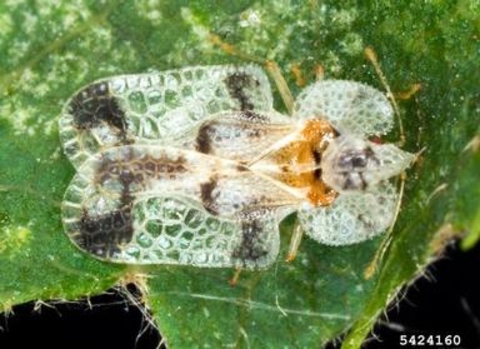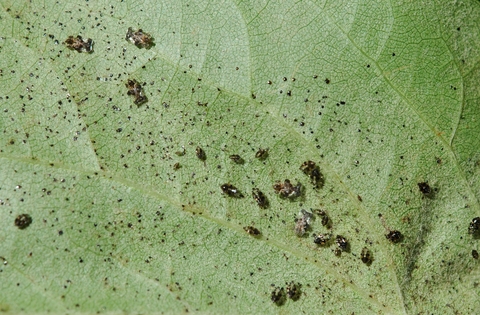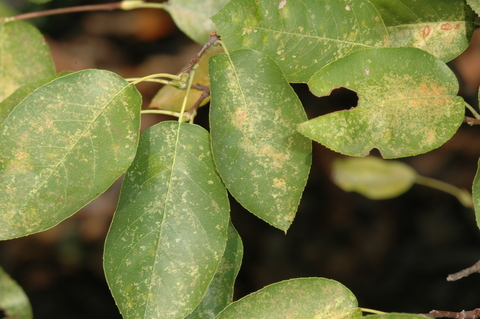Quick facts
- Adult and immature lace bugs feed on the undersides of leaves of deciduous trees and shrubs.
- Lace bug feeding can discolor leaves, but does not normally affect the health of woody plants.
- Management is normally not necessary.
- Pesticides can be effective in reducing lace bug numbers if treatment is necessary.
How to identify lace bugs
Adults
- 1/8 inch to 1/3 inch long.
- Light colored bodies with dark colored markings.
- Wings extend beyond the abdomen and are held flat.
- The top of their wings and thorax are sculptured and lacey in appearance.
Nymphs
- Wingless.
- Spiny with a flat oval-shaped body.
- Darker than adults.
When lace bug nymphs molt their exoskeletons, their cast skins remain attached to the foliage of the plant.
Adults and nymphs also leave very small, dark droppings on the undersides of leaves.
Lace bugs feed on many trees and shrubs in Minnesota, especially hackberry, walnut, basswood, white oak, bur oak, willow, chokecherry, hawthorn, cotoneaster and amelanchier (juneberry/serviceberry).
Lace bugs have two generations per growing season in Minnesota. They live through the winter, as adults on or near their host plants.
They can be found in bark crevices and under leaves and other debris on the ground next to these plants.
- In the spring, adults fly to plants and feed on newly-expanding leaves.
- Adults mate and lay tiny black eggs in small groups on the underside of the leaves.
- Eggs hatch into nymphs after about two weeks.
- Nymphs feed for about three to four weeks and mature into winged adults that lay additional eggs.
- Second-generation adults feed until late summer or fall.
- Adults from the second generation overwinter and begin the cycle anew the following spring.
Damage caused by lace bugs
- Adults and nymphs feed on the underside of leaves by inserting needle-like mouthparts into leaf tissue.
- This creates small, white or yellow mottled spots on the upper leaf surface.
- Feeding damage is most noticeable in mid to late summer when populations are at their highest.
- Heavy feeding can cause severe leaf discoloration and premature leaf drop.
- Healthy, mature trees and shrubs can tolerate damage by lace bugs.
- If feeding happens for several consecutive years, plant growth can be reduced in new transplants.
- Lace bug populations and the extent of damage vary from year to year.
How to protect trees and shrubs from lace bugs
Check for lace bugs in late spring
Check for lace bugs on susceptible trees and shrubs, starting in late spring or early summer. Examine susceptible plants about once every two weeks. Pay close attention to plants that have had a history of infestation.
Tolerate their presence
Lace bugs generally do not affect plant health, and the best option in most cases is to tolerate and ignore their feeding. Many natural enemies, such as assassin bugs, lady beetles, green lacewings and other predators feed on lace bug eggs, nymphs and adults to help limit lace bug feeding.
Use a high pressure water spray
A high pressure water spray from a garden hose acts like a heavy rain, knocking nymphs off of small plants. Nymphs lack wings and cannot return to plants.
Target water sprays at the undersides of the leaves where lace bugs are feeding.
Using pesticides
When using pesticides, be sure to spray the undersides of the leaves where lace bugs are found.
Insecticidal soaps and horticultural oils, low risk products, are effective against lace bugs and have low impact on natural enemies. For good results:
- The product should come in direct contact with lace bugs.
- Repeat applications may be necessary.
Broad-spectrum pesticides are effective, but they will also kill natural enemies. Use these pesticides carefully:
- Bifenthrin, cyfluthrin, lambda cyhalothrin, permethrin and other pyrethroids (typically ending in –thrin)
- Acephate
- Carbaryl
Systemic insecticides, like imidacloprid and dinotefuran, are effective. These products move through the plant to the leaves.
CAUTION: These products are very toxic to bees. Avoid treating plants when possible. If making an application, wait until after the trees or shrubs have finished flowering to reduce pesticide exposure to bees. Do not apply systemic insecticides to the soil when bee attractive flowers are planted directly adjacent to trees.
Contact a tree care professional who is a licensed landscape pesticide applicator, if you would like a professional to treat your trees or shrubs.
CAUTION: Mention of a pesticide or use of a pesticide label is for educational purposes only. Always follow the pesticide label directions attached to the pesticide container you are using. Remember, the label is the law.
Reviewed in 2019





